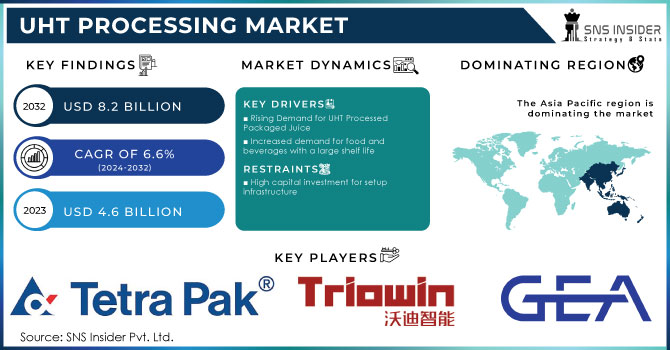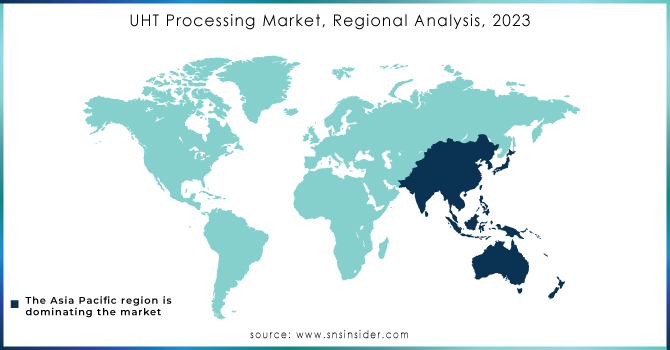UHT Processing Market Report Scope & Overview:

Get More Information on UHT Processing Market - Request Sample Report
The UHT Processing Market size was USD 4.6 billion in 2023 and is expected to reach USD 8.2 billion by 2032 and grow at a CAGR of 6.6% over the forecast period of 2024-2032.
UHT processing, also known as ultra-pasteurization or ultra-high temperature processing, is a food preservation technique that involves heating food to a high temperature (135-150°C) for a short period (2-5 seconds) and then cooling it rapidly. This process kills harmful bacteria and microorganisms, extending the shelf life of food products to several months without refrigeration.
There are two main types of UHT processing: direct and indirect. In direct UHT processing, the food is heated directly with steam. In indirect UHT processing, the food is heated indirectly by a hot water bath.
Milk and dairy desserts are the most important application sectors in the UHT processing market, accounting for the lion's share of the market. Temporary surpluses owing to seasonal changes can be compensated by subjecting milk to UHT and storing it for the off-season.
MARKET DYNAMICS
KEY DRIVERS
-
Rising Demand for UHT Processed Packaged Juice
-
Increased demand for food and beverages with a large shelf life
UHT maximizes the microbial decomposition of dairy products and dairy substitutes. With the help of this adaptable and affordable technology, aseptic packaging, a smaller carbon footprint, and novel product ranges are all made possible. People are increasingly looking for convenient and easy-to-prepare food and beverages. UHT-processed food products are a good option for these consumers as they can be stored for long periods of time without refrigeration.
RESTRAIN
-
High capital investment for setup infrastructure
The installation and operational costs of UHT processing systems can make it challenging for small and medium-sized firms to afford them. Because of this, there may be less competition in the market, which would raise consumer costs. Businesses may find it challenging to pass on the high cost of UHT processing to customers. This may reduce consumer demand for food that has undergone ultra-high temperature processing since they may not be willing to pay a higher price.
OPPORTUNITY
-
Untapped markets in Africa, South America, and Asia Pacific countries
Science and technological advancements have greatly increased the shelf life of food goods. The product market is growing as well, especially in countries like Botswana, Namibia, and Zambia where there is a need to sell UHT processing equipment to the tiniest foods and beverages. The populations of emerging markets are becoming increasingly urbanized. This is leading to a change in consumer preferences. Consumers in urban areas are more likely to demand convenient and ready-to-eat food products. UHT-processed food products are a good option for these consumers as they can be easily transported and stored.
CHALLENGES
-
To treat UHT, a large product quality requirement is required.
Some food products, such as delicate fruits and vegetables, are more sensitive to heat damage than others. This can make it difficult to produce UHT-processed versions of these products that meet consumer expectations for quality. For UHT Treatment, high-quality products are required. For instance, when milk is exposed to UHT, good-grade milk must be able to survive high-heat treatment.
IMPACT OF RUSSIAN UKRAINE WAR
Since the start of the war, the prices of raw materials for the UHT processing business have risen by an average of 15%. In addition, the supply networks for milk and dairy products were affected, resulting in higher pricing for these commodities. This could raise the cost of UHT processing. The European Union and the U.S. imposed economic sanctions on Russia. Russian enterprises may find it difficult to import UHT processing equipment and technology as a result of these bans. Political uncertainty has resulted from the war in Europe and Asia. This may result in less investment in the UHT processing market.
IMPACT OF ONGOING RECESSION
The recession has negatively impacted the UHT processing sector. In 2022, the cost of milk and items derived from milk increased by 2.5%. Because customers may be more inclined to buy less expensive food dairy products because they may have less disposable cash, this could result in a decline in demand for UHT-processed dairy products. Because of this, businesses may find it more difficult and costlier to import the dairy products and UHT processing machinery they require to make UHT-processed dairy products.
MARKET SEGMENTATION
By Mode of Operation
-
Direct Heating
-
Indirect Heating
By End-Product Form
-
Liquid
-
Semiliquid
By Application
-
Milk
-
Dairy Products
-
Juices
-
Dairy Alternatives
-
Others
REGIONAL ANALYSIS
Asia Pacific is a growing region with a CAGR value of 8.7 % for the UHT processing market in the world. The growth is due to the country's increased milk production and consumption, India has the largest share of the UHT processing industry. Thus, the biggest challenge in India is the processing and preservation before distribution and sale, and the processes involved in the treatment of milk or other beverages are costly, raising the cost of the end products. In India, aseptic packaging machines are expensive, and UHT milk is fully dependent on them.
The North American area has the substantial growth, led by the United States, owing to the convenience of functional drinks, the health benefits they provide due to a busy lifestyle, and increased health consciousness among consumers.
Europe was the most important region for the UHT processing industry, accounting for the majority of market share in the geography segment. The increased need for safe and healthy food products and rising consumer disposable income are driving expansion. Large dairy firms such as Danone, Savencia, Lactalis, and others are also based in Europe. These firms contribute significantly to market share.

Need any customization research on UHT Processing Market - Enquiry Now
REGIONAL COVERAGE
North America
-
US
-
Canada
-
Mexico
Europe
-
Eastern Europe
-
Poland
-
Romania
-
Hungary
-
Turkey
-
Rest of Eastern Europe
-
-
Western Europe
-
Germany
-
France
-
UK
-
Italy
-
Spain
-
Netherlands
-
Switzerland
-
Austria
-
Rest of Western Europe
-
Asia Pacific
-
China
-
India
-
Japan
-
South Korea
-
Vietnam
-
Singapore
-
Australia
-
Rest of Asia Pacific
Middle East & Africa
-
Middle East
-
UAE
-
Egypt
-
Saudi Arabia
-
Qatar
-
Rest of Middle East
-
-
Africa
-
Nigeria
-
South Africa
-
Rest of Africa
-
Latin America
-
Brazil
-
Argentina
-
Colombia
-
Rest of Latin America
KEY PLAYERS
Tetra Pak International S.A., Shanghai Triowin Intelligent Machinery Co. Ltd, SPX Flow, GEA Group, Microthermics Inc., Paul Muellar Company, Wilmar International Ltd, Repute Engineers Private Limited, Midland Food Group, Feldmeier Equipment Inc, Highland Equipment Inc., IMA Group, and other key players are mentioned in the final report.
RECENT DEVELOPMENTS
In 2023 Dairy Farmers of America introduced the first probiotics-fortified UHT milk as a low-cost alternative to kefir and Kombucha. DFA believes the product, created in collaboration with Good Culture, is the first lactose-free, long-life fluid milk on the US market to combine the nutritional benefits of dairy with probiotics that enhance the microbiota.
In 2023 Spanish dairy major Pascual started milk production in Africa. Refriango, an Angolan beverage manufacturer, is working with Pascual on the project. With a total of 19 references in Angola, five UHT and 14 powdered, Pascual will start local manufacturing of both UHT and powdered milk.
In 2022 Glanbia formally opened a new €15 million UHT factory in Lough Egish. The new facility will have a production capacity of 100 million liters per year and manufacture various UHT and cream products for international markets.
| Report Attributes | Details |
| Market Size in 2023 | USD 4.6 Billion |
| Market Size by 2032 | USD 8.2 Billion |
| CAGR | CAGR of 6.6% From 2024 to 2032 |
| Base Year | 2023 |
| Forecast Period | 2024-2032 |
| Historical Data | 2020-2022 |
| Report Scope & Coverage | Market Size, Segments Analysis, Competitive Landscape, Regional Analysis, DROC & SWOT Analysis, Forecast Outlook |
| Key Segments | • By Type of Operation, (Direct Heating and Indirect Heating) • By End-Product Form (Liquid and Semiliquid) • By Application (Milk, Dairy Products, Juices, Dairy Alternatives, and Others) |
| Regional Analysis/Coverage | North America (US, Canada, Mexico), Europe (Eastern Europe [Poland, Romania, Hungary, Turkey, Rest of Eastern Europe] Western Europe] Germany, France, UK, Italy, Spain, Netherlands, Switzerland, Austria, Rest of Western Europe]), Asia Pacific (China, India, Japan, South Korea, Vietnam, Singapore, Australia, Rest of Asia Pacific), Middle East & Africa (Middle East [UAE, Egypt, Saudi Arabia, Qatar, Rest of Middle East], Africa [Nigeria, South Africa, Rest of Africa], Latin America (Brazil, Argentina, Colombia Rest of Latin America) |
| Company Profiles | Tetra Pak International S.A., Shanghai Triowin Intelligent Machinery Co. Ltd, SPX Flow, GEA Group, Microthermics Inc., Paul Muellar Company, Wilmar International Ltd, Repute Engineers Private Limited, Midland Food Group, Feldmeier Equipment Inc, Highland Equipment Inc., IMA Group |
| Key Drivers | • Rising Demand for UHT Processed Packaged Juice • Increased demand for food and beverages with a large shelf life |
| Market Opportunity | • Untapped markets in Africa, South America, and Asia Pacific countries |

